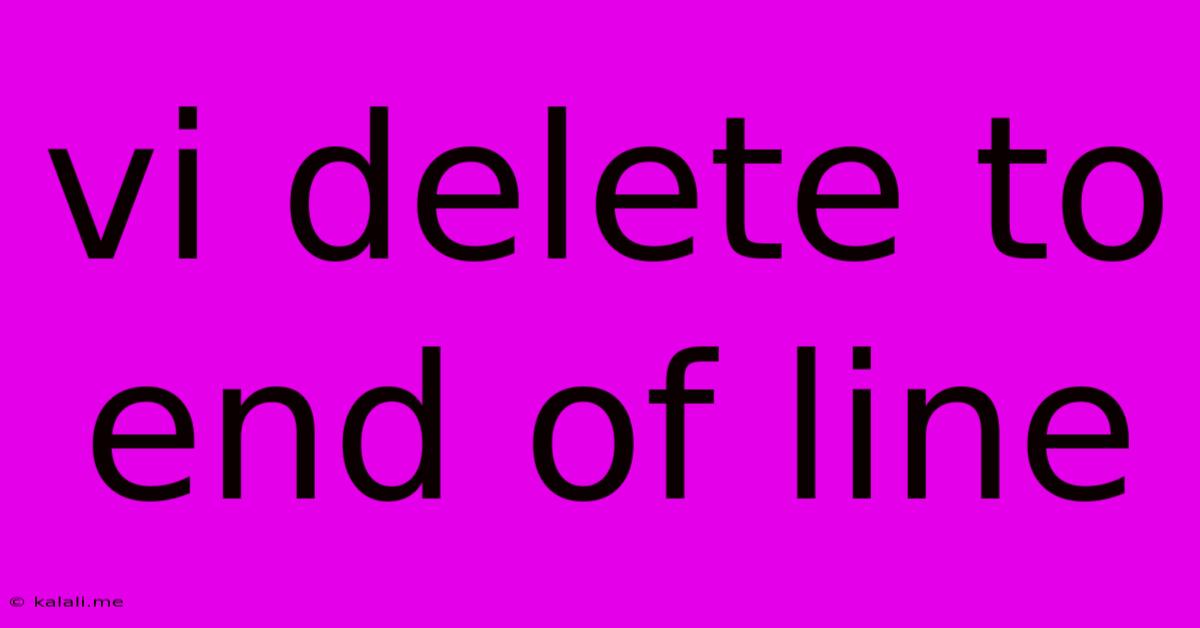Vi Delete To End Of Line
Kalali
May 24, 2025 · 3 min read

Table of Contents
Vi Delete to End of Line: Mastering the d$ Command
Deleting text in vi (or vim) is a fundamental skill for any Linux user. While there are several ways to delete text, efficiently deleting to the end of the current line is a common task. This article will explore the powerful d$ command, showing you how to use it effectively and improve your vi editing workflow. This tutorial covers the basics and will help even beginner users master this essential command.
Understanding the d$ Command:
The d$ command in vi is a concise and efficient way to delete all characters from the cursor's current position to the end of the line. It combines the delete command (d) with the motion command ($), which moves the cursor to the end of the line. Therefore, d$ means "delete from the cursor to the end of the line". This simple command saves you keystrokes and time compared to using other, longer methods.
How to Use d$:
- Open your file in vi: Use the command
vi filenameto open the file you want to edit. - Navigate to the line: Use the arrow keys or other navigation commands (like
j,k,h,l) to move the cursor to the line containing the text you want to delete. - Position the cursor: Place your cursor at the point within the line where you want to start the deletion.
- Execute the command: Type
d$and press Enter. The text from your cursor position to the end of the line will be deleted.
Examples:
Let's consider a line of text: "This is a sample line of text."
- If the cursor is at the beginning of the line (on "T"),
d$will delete the entire line. - If the cursor is on the "s" in "sample",
d$will delete "ample line of text." - If the cursor is on the last character ("."),
d$will delete nothing.
Beyond the Basics: Combining d$ with Other Commands:
The power of d$ extends beyond its basic functionality. You can combine it with other vi commands to perform more complex edits. For instance:
yy+d$: This combination first yanks (copies) the current line (yy) and then deletes the rest of the line (d$). This is useful if you need to keep a copy of the deleted text.- Visual Mode +
d$: In visual mode (enter visual mode usingv), select a portion of text, then executed$to delete from the end of the selected text to the end of the line.
Troubleshooting:
If d$ isn't working as expected, double-check that you're in normal mode (press the Esc key if you're in insert or visual mode). Ensure your cursor is positioned correctly before executing the command.
Conclusion:
Mastering the d$ command is crucial for efficient vi editing. Its simplicity and power make it an indispensable tool for any vi user. By understanding its functionality and integrating it into your workflow, you’ll significantly improve your editing speed and accuracy. Remember to practice regularly to solidify your understanding and build muscle memory for this vital command. With consistent use, d$ will become second nature, dramatically increasing your productivity within the vi editor.
Latest Posts
Latest Posts
-
Which Word Has The Most Positive Connotation
Jul 15, 2025
-
How Do I Send An Evite Reminder
Jul 15, 2025
-
When Performing A Self Rescue When Should You Swim To Shore
Jul 15, 2025
-
How Many Decaliters Are In A Liter
Jul 15, 2025
-
What Note Sits In The Middle Of The Grand Staff
Jul 15, 2025
Related Post
Thank you for visiting our website which covers about Vi Delete To End Of Line . We hope the information provided has been useful to you. Feel free to contact us if you have any questions or need further assistance. See you next time and don't miss to bookmark.